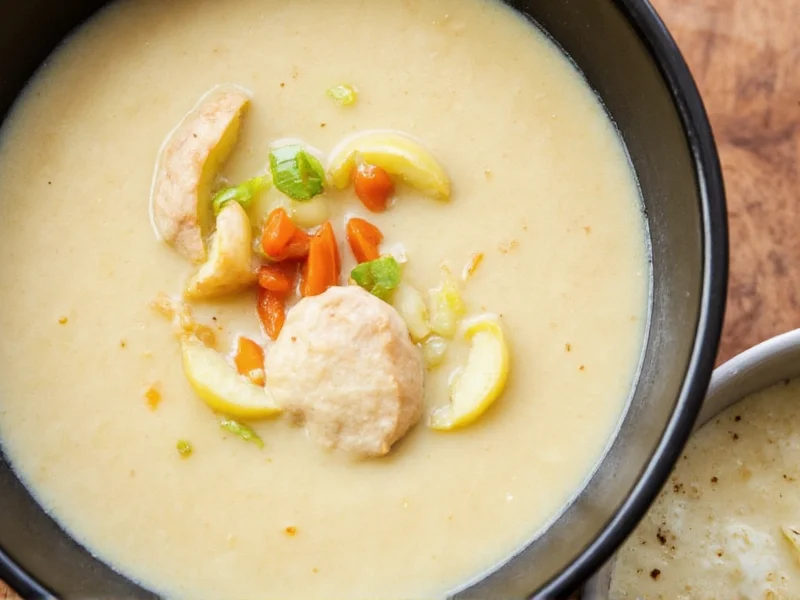Creating a comforting bowl of potato soup doesn't need to be complicated. This straightforward recipe delivers creamy, flavorful results using pantry staples you likely already have. Perfect for weeknight dinners or meal prep, this basic potato soup recipe serves 4 and can be customized to suit various dietary preferences while maintaining its classic comfort food appeal.
Essential Ingredients for Basic Potato Soup
The beauty of this recipe lies in its simplicity. Each ingredient serves a specific purpose in creating the perfect texture and flavor profile. Using quality ingredients makes a noticeable difference in the final result.
| Ingredient | Amount | Why It Matters |
|---|---|---|
| Yukon Gold potatoes | 2 lbs (about 4 medium) | Naturally buttery flavor and creamy texture when cooked |
| Yellow onion | 1 medium, diced | Provides essential savory base flavor |
| Garlic | 2 cloves, minced | Adds depth without overpowering |
| Vegetable or chicken broth | 4 cups | Creates flavorful base without heavy cream |
| Unsalted butter | 2 tablespoons | Enhances richness and helps sauté vegetables |
| Salt and pepper | To taste | Essential for balanced flavor development |
Equipment You'll Need
Gather these basic kitchen tools before starting:
- 4-quart heavy-bottomed pot or Dutch oven
- Sharp chef's knife
- Cutting board
- Wooden spoon or silicone spatula
- Immersion blender (or regular blender)
- Measuring cups and spoons
Step-by-Step Cooking Instructions
- Prepare ingredients: Peel and dice potatoes into 1/2-inch cubes. Finely dice onion and mince garlic.
- Sauté aromatics: Melt butter in pot over medium heat. Add onions and cook until translucent (5 minutes). Add garlic and cook for 1 minute until fragrant.
- Add potatoes and broth: Stir in diced potatoes and pour broth over them. Season with 1 teaspoon salt and 1/4 teaspoon black pepper.
- Simmer until tender: Bring to boil, then reduce heat to low. Cover and simmer for 15-20 minutes until potatoes are fork-tender.
- Blend to desired consistency: Use immersion blender directly in pot to create smooth soup. For chunkier texture, blend only half the soup.
- Adjust seasoning: Taste and add more salt and pepper as needed. For richer flavor, stir in 1-2 tablespoons of cream or milk if desired.
Common Mistakes to Avoid in Basic Potato Soup Recipe
Even simple recipes can go wrong if you miss these critical details:
- Using the wrong potato variety: Russet potatoes work but create a grainier texture. Yukon Gold provides natural creaminess without added dairy.
- Adding cold liquid to hot pot: Always use room-temperature or warm broth to prevent temperature shock that can affect texture.
- Over-blending: Blend just until smooth—over-processing can make soup gluey due to released starches.
- Seasoning too early: Salt potatoes toward the end of cooking as reduced liquid concentrates saltiness.
- Boiling too vigorously: Maintain a gentle simmer to prevent potatoes from breaking down too much.
Customizations for Your Basic Potato Soup
This easy potato soup recipe for beginners adapts well to various preferences:
- Vegetarian version: Use vegetable broth instead of chicken broth
- Vegan adaptation: Substitute butter with olive oil and skip dairy additions
- Protein boost: Add 1 cup diced cooked chicken or 1/2 cup white beans
- Vegetable additions: Stir in 1 cup diced carrots or celery with the onions
- Flavor variations: Add 1/2 teaspoon dried thyme, rosemary, or a bay leaf during simmering
Storage and Reheating Guidelines
Proper storage ensures your homemade creamy potato soup maintains quality:
- Refrigeration: Store in airtight container for up to 4 days
- Freezing: Freeze for up to 3 months (note: texture may change slightly)
- Reheating: Warm gently over medium-low heat, stirring frequently. Add splashes of broth if too thick
- Reviving leftovers: Stir in 1-2 tablespoons milk or cream when reheating for refreshed creaminess
Frequently Asked Questions
Can I make potato soup without an immersion blender?
Yes, you can make basic potato soup recipe without specialized equipment. Transfer cooled soup in batches to a regular blender, being careful not to fill more than halfway. Cover with a towel and hold lid firmly while blending. Alternatively, use a potato masher for a chunkier texture that still delivers great flavor.
What's the best potato variety for creamy soup?
Yukon Gold potatoes create the creamiest texture for basic potato soup recipe without heavy cream. Their naturally buttery flavor and medium starch content produce a velvety consistency when blended. Russets work but require more liquid as they absorb more broth, while red potatoes maintain too much structure for smooth soup.
How can I prevent my potato soup from becoming watery?
To maintain perfect consistency in your easy potato soup recipe for beginners, avoid adding too much liquid initially. Potatoes release starch as they cook, naturally thickening the soup. If soup becomes too thin, simmer uncovered for 5-10 minutes to reduce liquid, or mash some potatoes against the pot side to release more starch. For quick thickening, mix 1 tablespoon cornstarch with 2 tablespoons cold water and stir into simmering soup.
Can I prepare this potato soup recipe ahead of time?
Absolutely. This classic potato soup cooking time and temperature method actually improves when made ahead. Prepare the soup completely, cool, and store in the refrigerator for up to 3 days. The flavors meld beautifully overnight. When reheating, add small amounts of broth as needed since potatoes continue absorbing liquid during storage. For best results, hold back any dairy additions until reheating.
How do I fix potato soup that's too salty?
If your basic potato soup recipe becomes over-salted, add peeled, raw potato chunks (about 1/2 cup) to the pot and simmer for 10-15 minutes. The potatoes will absorb excess salt. Alternatively, dilute with additional unsalted broth or water. Adding a small amount of acid like lemon juice or vinegar (1/2 teaspoon at a time) can also help balance excessive saltiness in your homemade creamy potato soup.











 浙公网安备
33010002000092号
浙公网安备
33010002000092号 浙B2-20120091-4
浙B2-20120091-4